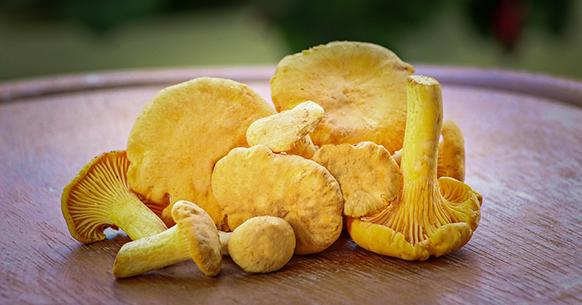
I chanterelle mushrooms they are the best known and most appreciated mushrooms in the kitchen. They are used both fresh, cooked in oil with garlic and parsley, and dried. It is possible to find them in summer and autumn, in coniferous or broad-leaved woods, in mossy soils. It grows in groups, often in circles.
Chanterelle mushrooms, description
In the official nomenclature the gallinaccio, another name of the chanterelle mushrooms, is indicated as Cantharellus Cibarius, belongs to the Cantharellaceae family and the name derives from its shape; the cantaro in fact for the Latins meant a cup to contain.
Its hat is convex in shape, smooth and yellow in color
shiny, with wavy edges, like a rooster's comb, but the ways to indicate this edible mushroom they are really many: chanterelle, chanterelle, cockerel, gallitula, gialletto, garitula, gaddiniedde, according to the growing areas and local dialects.
Properties of chanterelle mushrooms
Chanterelle mushrooms are a food with a noteworthy energy intake which makes them suitable for a type of structured diet in the name of weight control:
> low calorie, 38 kcal in 100 g of mushrooms, divisible into energy by 71,9% carbohydrates, 15,6% proteins and 12,5% fats.
> Rich in B vitamins, to support the metabolic system: in particular the vitamin B2, B3, B5 e B6. B vitamins give energy to the body.
> They contain vitamin D2: skin-friendly vitamin, counteracts free radicals and the signs of aging. Vitamin D supports the absorption of calcium and phosphorus for the well-being of the bones. 100 g of chanterelle mushrooms can contain 5.3 micrograms of D2.
> antioxidants: Chanterelles contain ascorbic acid, more simply vitamin C, but sensitive to high temperatures: in fact it is lost when cooked or boiled in water. Ascorbic acid has an antioxidant action, protecting polyunsaturated fats from oxidation, participates in the synthesis of collagen and stimulates the immune system.
> provide mineral salts: iron, potassium, magnesium, phosphorus. In particular 100 g of chanterelle mushrooms contain 3,50 mg of iron, useful in conditions of anemia and in any case to support the necessary amount of hemoglobin.


























